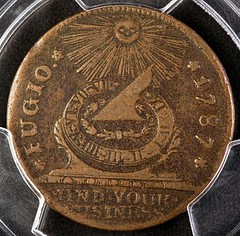
PREV ARTICLE
NEXT ARTICLE
FULL ISSUE
PREV FULL ISSUE
V25 2022 INDEX E-SYLUM ARCHIVE BEN FRANKLIN'S FUGIO CENTDick Hanscomb passed along this article about the Fugio cent. Thanks. Here's an excerpt - see the complete article online. -Editor
In Benjamin Franklin's 1737 book, Poor Richard's Almanac, he stated what would be his literal and figurative idea behind money, The Fugio cent was created in response to small currency coin shortages during that period, as the Colonies were tired of relying on Great Britain's supply of coins, particularly small currency copper coins, the production of which was paused in 1775. It is estimated that two-thirds of all copper coins traded in Great Britain were counterfeit by the mid 1780s, and in 1787 Great Britain began using privately made Conder Tokens made of copper for smaller currency.
On the back of the Franklin cent, introduced in 1787, there are thirteen rings symbolizing the original thirteen colonies in a literal sense. These linked rings create an unbroken chain encircling, Beyond its broader figurative significance, Franklin regarded the number thirteen as an important number in his own philosophy. Throughout the coin's design, Franklin imbues his ethical and moral positions along with literal and symbolic messaging. He provides an exact weight of 10 grams of copper, or 157.5 grains. Even the subtle addition of grooved edges is a homage to historical moral character and the relation to money as it equally deters clipping or counterfeiting. And there's more. In 1752, Franklin openly supported the change to the Gregorian calendar being used throughout the Colonies. Prior to that, only various colonies observed the same calendar year. The Gregorian calendar fits thirteen weeks in by a multiple of four, equaling a total of fifty-two weeks. With each week being dedicated to one of his key virtues for personal development, four times per year. The thirteen interlocking rings on the coin's design symbolize the colonies and Franklin's virtues. He believed every person should be responsible for their character building. Within his desire for personal development, he proposed thirteen virtues. In his philosophy of personal progress, he believed people should dedicate a week to practicing each of these respective virtues . After thirteen weeks, when each virtue has been practiced, the cycle begins anew, and this happens four times a year. Franklin believed if each person focused on these virtues for an entire week, four times per year, they would surely progress. This reflects Franklin's belief that virtue did not come naturally to humans, but was achieved over time through discipline. This was one reason Franklin saw time as precious, and he believed a country's liberty is made by each individual working on themself. As a Stoic, he understood life's delicate and finite number of years, all the way down to the importance of respecting others' time, as well as one's own. Contrary to popular myth, Franklin did not invent Daylight Savings, but he certainly believed in the importance of a strict schedule making the best use of daylight and personal progress throughout one's life.
This too is reflected in the Fugio Cent. On the front of the coin is a sun smiling and shining down onto a sundial, and within the sundial are hours of the day. The word Fugio imprinted on the left is a Latin word meaning
To read the complete article, see:
Wayne Homren, Editor The Numismatic Bibliomania Society is a non-profit organization promoting numismatic literature. See our web site at coinbooks.org. To submit items for publication in The E-Sylum, write to the Editor at this address: whomren@gmail.com To subscribe go to: https://my.binhost.com/lists/listinfo/esylum All Rights Reserved. NBS Home Page Contact the NBS webmaster 
|

